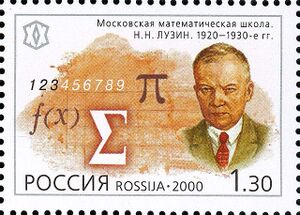Nikolai Luzin (nonfiction): Difference between revisions
Jump to navigation
Jump to search
No edit summary |
No edit summary |
||
| Line 1: | Line 1: | ||
'''Nikolai Nikolaevich Luzin''' (also spelled Lusin; Russian: Никола́й Никола́евич Лу́зин; IPA: [nʲɪkɐˈlaj nʲɪkɐˈlaɪvʲɪtɕ ˈluzʲɪn] 9 December 1883 – 28 January 1950) was a Soviet/Russian [[Mathematician (nonfiction)|mathematician]] known for his work in descriptive set theory and aspects of mathematical analysis with strong connections to point-set topology. | [[File:Nikolai Luzin stamp.jpg|thumb|Nikolai Luzin.]]'''Nikolai Nikolaevich Luzin''' (also spelled Lusin; Russian: Никола́й Никола́евич Лу́зин; IPA: [nʲɪkɐˈlaj nʲɪkɐˈlaɪvʲɪtɕ ˈluzʲɪn] 9 December 1883 – 28 January 1950) was a Soviet/Russian [[Mathematician (nonfiction)|mathematician]] known for his work in descriptive set theory and aspects of mathematical analysis with strong connections to point-set topology. | ||
He was the eponym of Luzitania, a loose group of young Moscow mathematicians of the first half of the 1920s. They adopted his set-theoretic orientation, and went on to apply it in other areas of mathematics. | He was the eponym of Luzitania, a loose group of young Moscow mathematicians of the first half of the 1920s. They adopted his set-theoretic orientation, and went on to apply it in other areas of mathematics. | ||
| Line 12: | Line 12: | ||
== Nonfiction cross-reference == | == Nonfiction cross-reference == | ||
* [[Andrey Kolmogorov (nonfiction)]] | |||
* [[Mathematician (nonfiction)]] | * [[Mathematician (nonfiction)]] | ||
Revision as of 17:12, 17 September 2017
Nikolai Nikolaevich Luzin (also spelled Lusin; Russian: Никола́й Никола́евич Лу́зин; IPA: [nʲɪkɐˈlaj nʲɪkɐˈlaɪvʲɪtɕ ˈluzʲɪn] 9 December 1883 – 28 January 1950) was a Soviet/Russian mathematician known for his work in descriptive set theory and aspects of mathematical analysis with strong connections to point-set topology.
He was the eponym of Luzitania, a loose group of young Moscow mathematicians of the first half of the 1920s. They adopted his set-theoretic orientation, and went on to apply it in other areas of mathematics.
In the News
Fiction cross-reference
Nonfiction cross-reference
External links:
- Nikolai Luzin @ Wikipedia
